WALLACE'S LINKS WITH LONGFORGAN |
In the McManus Galleries, Albert Square, Dundee, there resides an artefact associated with the earliest days of William Wallace's story. It is on public display, and we were fortunate enough to be allowed to photograph it by Christina Donald, Curator of Early History. It used to be on display in the old Barrack Street Museum, now closed, and the wording of the label describing it there is produced below. Scroll down to the bottom part of the page to see the new photographs. |
Wallace's Stone. A Stone with an interesting connection with Sir William Wallace and Longforgan has just been traced after its whereabouts had been unknown to the inhabitants of the village for a number of years. This stone was known as the Wallace Stone and lay for centuries at the Wallace cottage in that village. It now lies in Dundee Museum, Albert Square. It is known as a bere or knocking stone, used for pounding barley with a pestle in order to husk it. These stones were to be found at the door of most cottages in olden days. During the troubled times when Edward 1 of England was endeavouring to establish his overlordship of Scotland, Sir Malcolm Wallace of Elderslie, who sturdily refused to bend to the yoke of the English usurper, sent his young son with his mother to the care of a relative at Kilspindie, in the Carse of Gowrie. Friend Stabbed. From there young Wallace was sent for schooling to the Dundee School, where he met with another lad, the only son of Selby, the English Governor of Dundee at the time. One day when Wallace appeared wearing a suit of green short cloth and a belt with a dirk, young Selby objected to the get-up and wanted to take the dirk from Wallace. A scuffle ensued in which Selby was fatally wounded. Wallace fled to a house in the Overgate, where he sheltered, disguised as a girl at a spinning wheel, while the hunt was made for him. The Governor, Selby, had said he would burn down the town to find Wallace. Later, Wallace was able to escape from the town and set out along the Carse towards his home at Kilspindie. On the road he asked for some food at a dwelling in Longforgan, and while the goodwife was getting him something to eat, Wallace sat down on the flat cover stone of the knocking stone. This would probably be the first moment on which he had time to think of what the killing of young Selby would mean. First Blow. This was the first blow Wallace struck for Scotland, and probably influenced the rest of his career. The family then dwelling at the site now known as the Wallace cottage, of the name of Smith, continued living on the same site for over 500 years. They were weavers and small farmers. When the last member of the family left Longforgan and moved to Dundee in 1860, the stone was given into the custody of the Laird of Castle Huntly at Longforgan, where it remained until 1946. After the death of the last Laird, his widow donated the stone to Dundee Museum. |
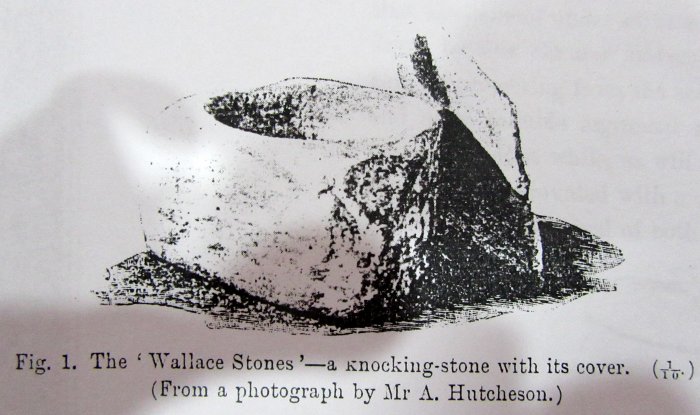 | |
Engraving of the stones from the 1900 PSAS Report |
|
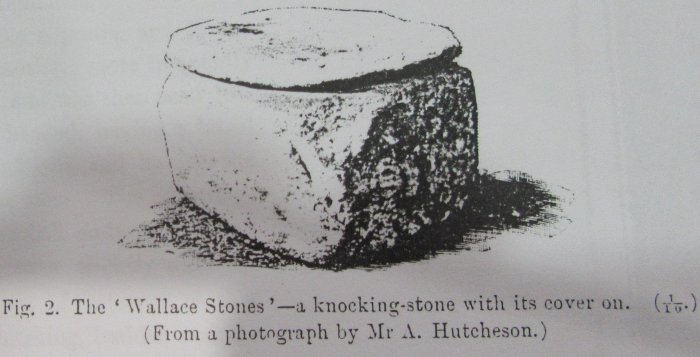 | |
Engraving of the stones from the 1900 PSAS Report |
|
Source: Proceedings of the Society of Antiquities in Scotland, May 14, 1900 III. Notice of the Wallace Stones, Longforgan, by Alexander Hutcheson, F.S.A. Scot., Broughty Ferry. Hutcheson makes reference to a manuscript in the possession of Mr Paterson of Castle Huntly, dating from around 1760, which he quotes extensively and verbatim. "Among the curiosities of theis Lordship their is on the Village of Longforgan omited formerly which I shall mention here, viz:- In the reign of Edward Longshanks of England Sir William Wallace of Elerslie, Barronet, being a promising youth of 14 years of age was sent from there to his uncle's than proprietor of Kilspindie for his Education, who sent him to the School of Dundie - the Mayor of Dundie at that time was a Yorkshire Gentleman of the name of Selbie, who had on only son of 16 years of age was likewise at school there. On day when all the Schoolars was at play at the west port of that town Young Selbie found fault with Wallace for having a Suit of short Green Clothes with a belt from thence depended a Durk or Skene. This weapon is still pratised in Scotland and is very Dangerous in Close Combat, it serves for manual uses as well as for Defence; it is ten Inches Long in the Blade and two edged with a row of holls up the midle, the handle is five inches Long, it hings befor on the Belly - this Weapon young Selbie wanted from Wallace at anyrate, so that a scuffle inshued between the two young Heroes. four times Wallace threw his antagonist on the ground, at the fifth atack Wallace drew his Skene and stobed young Selbie to the Heartand then fled to a house on the Northside of the Overgate of that town where he was well screened by the female Sex while the English Garishon vended their fury on the inhabitants of the town and would have Laid it in ashes if it had not been for the interposition of Sir John Scrimger of Dudup who went to his knees and stopted their fury. As this was our Scots-worthy's Exploits Let us return to him. Wallace being conducted safe out at the West Port fled up the Tayside. The first halt he made was at a house in Lonforgan and sat Down at the Door of said house on a stone which serves for a knocking stone and hear the Hospitall Landlady give him an ample repast of Bread and Milk. from there he proceededto Killspindie, but his Uncle fearing a Search from Dundie sent our young Hero with his wife over the ferry at Lindors on their way to Dinipce in Stirllingshire where he was safe at that time. But to return, that stone at the house in Longforgan still goes by the name of the Wallace Stone, and what is more remarkable ever since the for-mentioned period of Wallace, the name of Smith from father to son hath been Landlords of this House and how long before is not known, only this on thing among all the Revolitions of time they have been very carfull in preserving this stone as a piece of great Antiquity." A full transcript complete with the original spelling. His description of the stones reads thus: "A short description of the stone or stones is now desirable. The larger of the two stones (fig. 1), which is the only one described or referred to usually in giving the tradition, is what was known amongst country people as a 'knocking stone' - a stone mortar for husking or preparing barle for cooking purposes. It measures externally about 15 inches across, by about 10 inches in height. The basin or hollow in the stone is 9 inches in diameter at the top, slightly less at the bottom, and 6-1/2 inches in depth. Apart from the hollow, the stone has not otherwise been shaped or dressed. It is a rudely rhomboidal block, apparently of Kingoodie sandstone, the edges and angles rounded by the weather or attrition. The other stone, which accompanies it, and which ought perhaps to be regarded as the real 'Wallace Stone', since it and not the other formed the seat, is a thin undressed slab of a hard-grained sandstone, not more than 1-1/2 inches in thickness, and otherwise of such dimensions as just to cover the lower stone, which was indeed its purpose (fig, 2). The under side of the slab appears to have been painted, and exhibits, when turned up to the light, many lines of circular striation such as would naturally be formed by contact with the lips of the trough when in the process of being placed as a cover; it was moved round in a circular direction until the position where it fitted the lower stone was reached. That this circular striation is an important testimony to the antiquity of the two stones may be judged from the fac that the general under-surface of the upper stone has been so much worn down by this circular movement as to leave one or two small hard pebbles projecting from the semi-polished and striated surface. Another and more forcible argument may be drawn from the association of the two stones, that while, as will after appear, every such knocking-stone in Scotland was provided with a covering stone, in not another instance do I know of the survival of both the associated stones." |
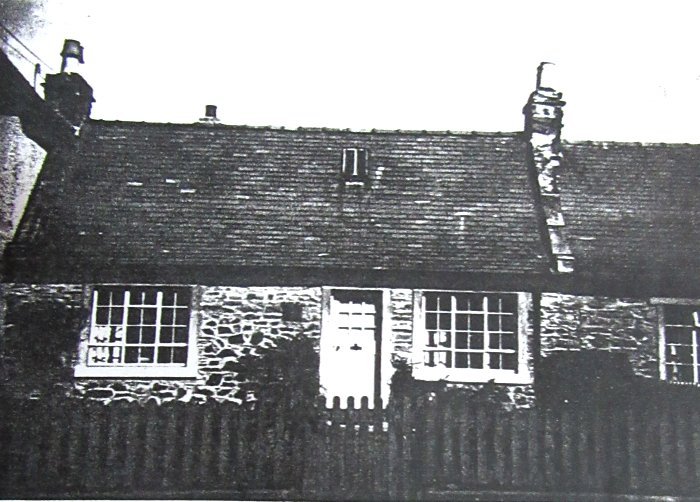 | |
Old photograph of the Wallace Cottage |
|
Source: J.Thomson, "History of Dundee" published 1847, p.26 "A respectable family of the name of Smith, in the village of Longforgan, is in possession of a stone which is looked upon with great veneration, and preserved with the most scrupulous care. This stone is hollow, and seems to have been, in the simple days of yore, used for the purpose of unhusking barley for the pot. The circumstance that makes it valuable and venerable in the eyes of its possessors and visitors is the universally-believed fact, that it is the identical stone upon which the youthful hero rested himself in his flight from Dundee to the castle of Kilspindie, in the Carse, the seat of his maternal uncle. There is also a universally received tradition, that the good-woman of the house, to whom the stone belonged, refreshed the exhausted Wallace with a meal of bread and milk, and that the stone has been handed down from father to son, as an heirloom, during a period of five centuries and a half. When we saw this relic of the days of old, so closely associated with the memory of the illustrious hero, we found it carefully laid aside, clean, and as neatly caum-stoned over as the hearth of the very tidy cottage within which it is preserved." |
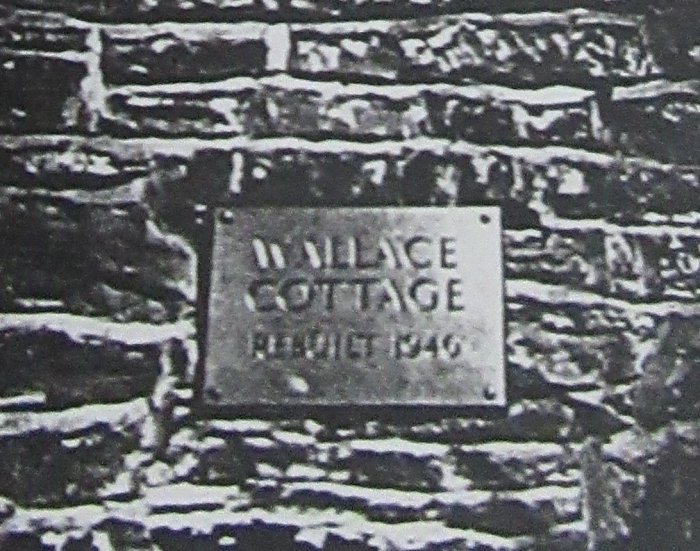 | |
Wallace Cottage "Rebuilt 1946" sign |
|
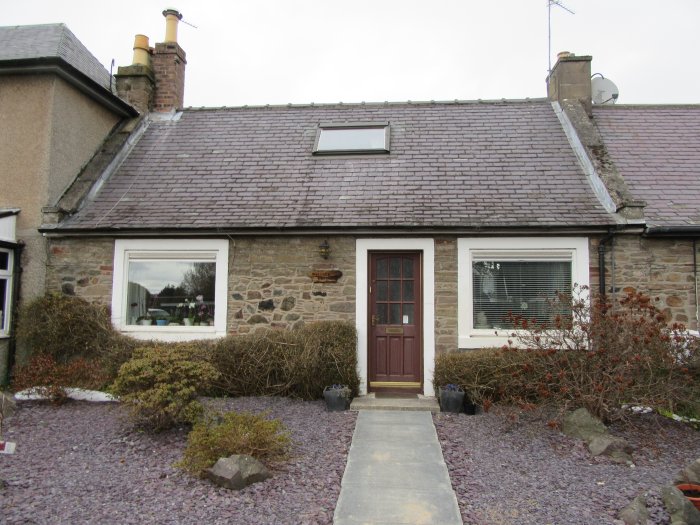 | |
Wallace Cottage as it looks now (courtesy of the current owner) |
|
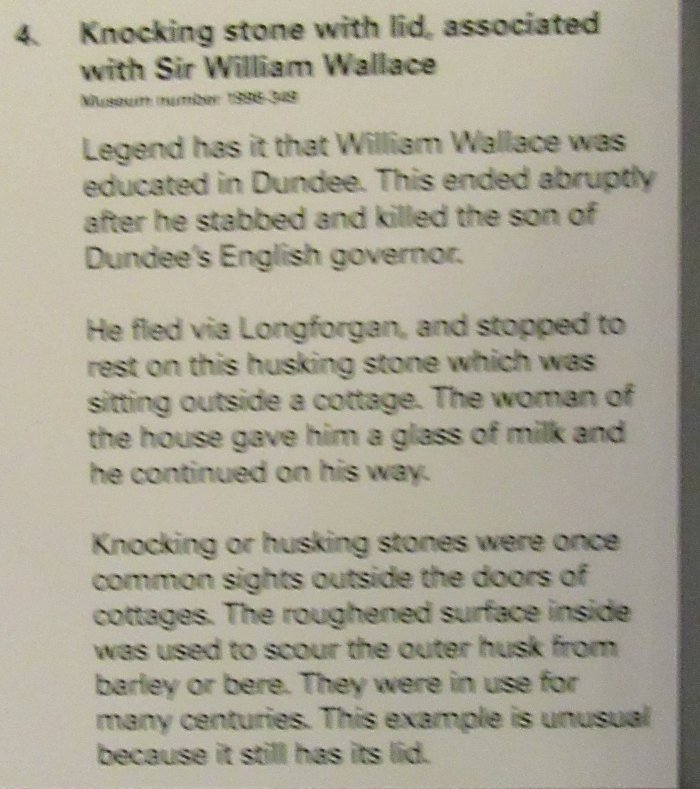 | |
The current label for the Wallace Stones |
|
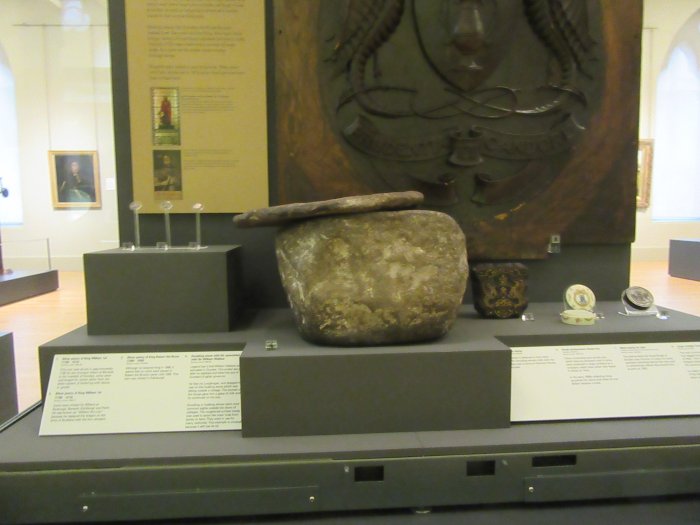 | |
The display |
|
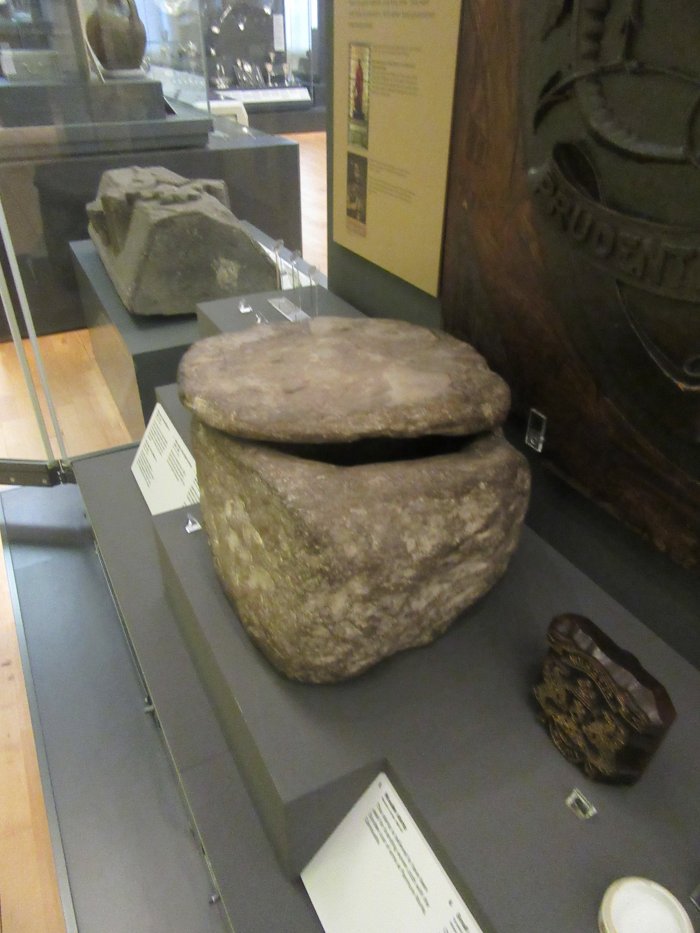 | |
The display |
|
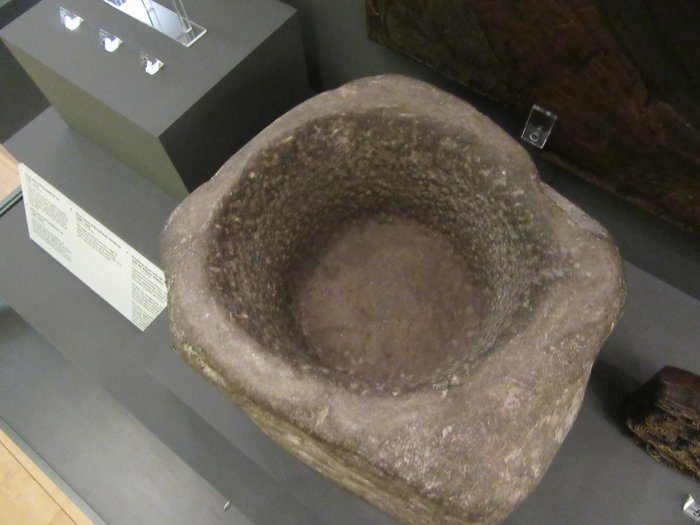 | |
The lower stone with lid removed |
|
 | |
Christina displays the underside of the lid |
|
 | |
Portrait of Wallace from a 1790 edition of Blind Harry's poem |
|
Please note that these new photographs are © Society of William Wallace, 2018, and may not be redistributed without permission. Contact the webmaster if you wish to use them, permission will always be granted for personal use - but not for financial purposes. |
|
| © Society of William Wallace 2007-2026 | The Society of William Wallace is a Scottish Charitable Incorporated Organisation Registration number SC045959 |
